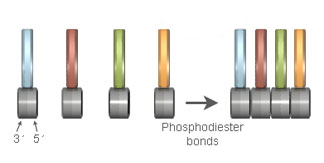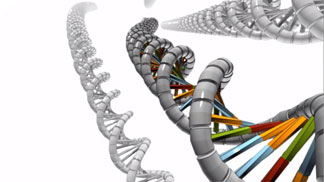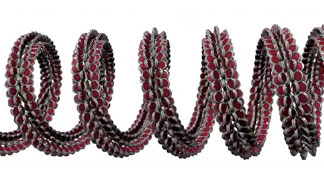« Prev Next »

DNA Is a Structure That Encodes Biological Information
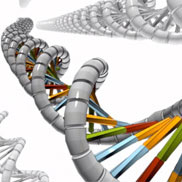
DNA is found in nearly all living cells. However, its exact location within a cell depends on whether that cell possesses a special membrane-bound organelle called a nucleus. Organisms composed of cells that contain nuclei are classified as eukaryotes, whereas organisms composed of cells that lack nuclei are classified as prokaryotes. In eukaryotes, DNA is housed within the nucleus, but in prokaryotes, DNA is located directly within the cellular cytoplasm, as there is no nucleus available.
But what, exactly, is DNA? In short, DNA is a complex molecule that consists of many components, a portion of which are passed from parent organisms to their offspring during the process of reproduction. Although each organism's DNA is unique, all DNA is composed of the same nitrogen-based molecules. So how does DNA differ from organism to organism? It is simply the order in which these smaller molecules are arranged that differs among individuals. In turn, this pattern of arrangement ultimately determines each organism's unique characteristics, thanks to another set of molecules that "read" the pattern and stimulate the chemical and physical processes it calls for.
What components make up DNA?
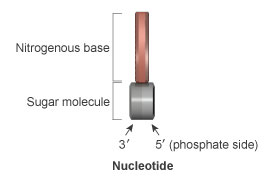

How is the DNA strand organized?
Although DNA is often found as a single-stranded polynucleotide, it assumes its most stable form when double stranded. Double-stranded DNA consists of two polynucleotides that are arranged such that the nitrogenous bases within one polynucleotide are attached to the nitrogenous bases within another polynucleotide by way of special chemical bonds called hydrogen bonds. This base-to-base bonding is not random; rather, each A in one strand always pairs with a T in the other strand, and each C always pairs with a G. The double-stranded DNA that results from this pattern of bonding looks much like a ladder with sugar-phosphate side supports and base-pair rungs.
Note that because the two polynucleotides that make up double-stranded DNA are "upside down" relative to each other, their sugar-phosphate ends are anti-parallel, or arranged in opposite orientations. This means that one strand's sugar-phosphate chain runs in the 5' to 3' direction, whereas the other's runs in the 3' to 5' direction (Figure 4). It's also critical to understand that the specific sequence of A, T, C, and G nucleotides within an organism's DNA is unique to that individual, and it is this sequence that controls not only the operations within a particular cell, but within the organism as a whole.
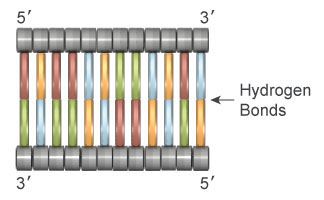
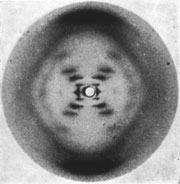
Around the same time, researchers James Watson and Francis Crick were pursuing a definitive model for the stable structure of DNA inside cell nuclei. Watson and Crick ultimately used Franklin's images, along with their own evidence for the double-stranded nature of DNA, to argue that DNA actually takes the form of a double helix, a ladder-like structure that is twisted along its entire length (Figure 6). Franklin, Watson, and Crick all published articles describing their related findings in the same issue of Nature in 1953.
How is DNA packaged inside cells?
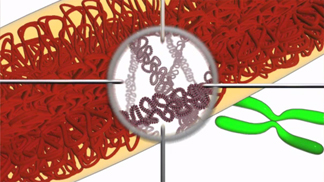
Most cells are incredibly small. For instance, one human alone consists of approximately 100 trillion cells. Yet, if all of the DNA within just one of these cells were arranged into a single straight piece, that DNA would be nearly two meters long! So, how can this much DNA be made to fit within a cell? The answer to this question lies in the process known as DNA packaging, which is the phenomenon of fitting DNA into dense compact forms (Figure 7).
During DNA packaging, long pieces of double-stranded DNA are tightly looped, coiled, and folded so that they fit easily within the cell. Eukaryotes accomplish this feat by wrapping their DNA around special proteins called histones, thereby compacting it enough to fit inside the nucleus (Figure 8). Together, eukaryotic DNA and the histone proteins that hold it together in a coiled form is called chromatin.

How do scientists visualize DNA?
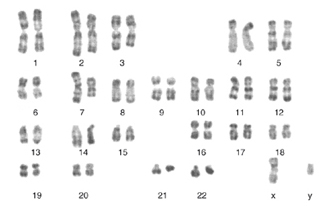
It is impossible for researchers to see double-stranded DNA with the naked eye — unless, that is, they have a large amount of it. Modern laboratory techniques allow scientists to extract DNA from tissue samples, thereby pooling together miniscule amounts of DNA from thousands of individual cells. When this DNA is collected and purified, the result is a whitish, sticky substance that is somewhat translucent.
To actually visualize the double-helical structure of DNA, researchers require special imaging technology, such as the X-ray diffraction used by Rosalind Franklin. However, it is possible to see chromosomes with a standard light microscope, as long as the chromosomes are in their most condensed form. To see chromosomes in this way, scientists must first use a chemical process that attaches the chromosomes to a glass slide and stains or "paints" them. Staining makes the chromosomes easier to see under the microscope. In addition, the banding patterns that appear on individual chromosomes as a result of the staining process are unique to each pair of chromosomes, so they allow researchers to distinguish different chromosomes from one another. Then, after a scientist has visualized all of the chromosomes within a cell and captured images of them, he or she can arrange these images to make a composite picture called a karyotype (Figure 10).
Further Exploration
Key Questions
eBooks
This page appears in the following eBook




